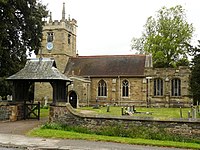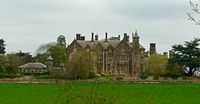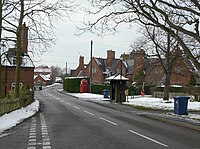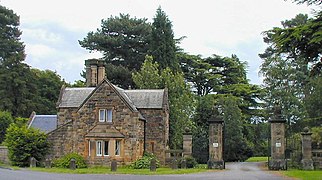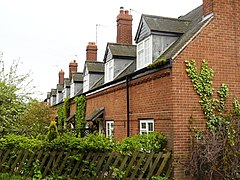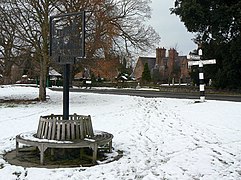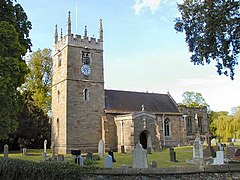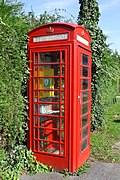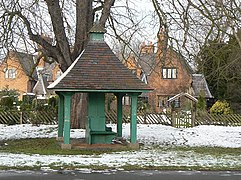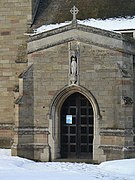Kingston on Soar
| Kingston on Soar | |
| Nottinghamshire | |
|---|---|
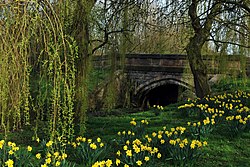 Spring Brook, Kingston on Soar | |
| Location | |
| Grid reference: | SK501276 |
| Location: | 52°50’38"N, 1°15’22"W |
| Data | |
| Population: | 296 (2011) |
| Post town: | Nottingham |
| Postcode: | NG11 |
| Dialling code: | 01509 |
| Local Government | |
| Council: | Rushcliffe |
| Parliamentary constituency: |
Rushcliffe |
Kingston on Soar is a village in Nottinghamshire, in the south of the county, close to the River Soar, which here forms the county border with Leicestershire.
The River Soar does not pass through the village, but very close by to the west, doing its duty to mark the border with Leicestershire. The Kingston Brook drains west through the village.
Nearby places are Kegworth in Leicestershire and, further downstream, Ratcliffe on Soar.
History
The Domesday Book, written in 1086, records the village as 'Chinestan'.
John Berridge (1717–93) was born into a Kingston on Soar farming family but soon realised he had little talent for the land.[1] He entered Cambridge University and then the ministry of the Church of England. In this he was at first totally inept, but in 1757 experienced a religious conversion while reading the Bible and became a great preacher at Everton in Bedfordshire. His visitors included John Wesley and Selina, Countess of Huntingdon. His sermons were often met with 'strange convulsions' in the congregation, and people falling down as if dead, described in detail in Wesley's journals in 1758-9. Berridge's tomb at Everton is famous for its evangelistic inscription. His funeral was conducted by Charles Simeon.
John Throsby, writing during 1790 in his new edition of Robert Thoroton's Antiquities of Nottinghamshire, describes Kingston on Soar:<refname=th>Thoroton, Robert: Parishes: Kinston: Antiquities of Nottinghamshire] (1790) on British History Online</ref>
This Lordship contains 1100 acres of old inclosed land, divided into 3 farms, exclusive of some patches of home ground, attached to some inferior dwellings: It belongs chiefly to the Duke of Leeds, who is lord of the manor. [...] The village contains about 30 dwellings.
White's Directory of Nottinghamshire, written in 1853, describes Kingston on Soar:[2]
Kingston-Upon-Soar is a small village and parish 10 miles south west by south of Nottingham, betwixt the Wolds and the Leicestershire border.
Parish church
The parish church is St Winifred's, a Grade I listed building.[3]
The church dates back to about 1540, when records show the chancel was built under the Babington family of Dethick.[4] Before this, Kingston on Soar belonged to the parish of Ratcliffe-on-Soar, and a chapel-of-ease stood in Kingston, dating back to the late 11th or early 12th century.
The tomb of the Edward Strutt, 1st Baron Belper is to be found in the churchyard.
Simon Jenkins listed St Winifred's in his book, England's Thousand Best Churches.
About the village
Kingston Hall is a large Grade II listed country house, built 1842-46 for Mr Edward Strutt, who would later become the 1st Lord Belper.[5] The hall was built by the architect Edward Blore[5] who had previously worked on Buckingham Palace.[6] Ronald Strutt, the 4th Lord Belper, sold the hall in 1976.[7] In 1980 the hall was converted into 12 individual dwellings and the surrounding buildings were sold for separate occupation.
The grounds of Kingston Hall contain three Grade II listed structures: a garden pavilion, a stable block and a lodge with an attached gateway.
Kingston Park Pleasure Gardens, which surround Kingston Hall, are also Grade II listed.[7]
The precursor to the Midland Agricultural and Dairy College (which became the University of Nottingham's Sutton Bonington Campus in the neighbouring parish of Sutton Bonington) was the Midland Dairy Institute and was located in the parish of Kingston on Soar. Stilton cheese was made along with other types at the Institute.[8] The University Farm, a 1,100-acre commercial research farm, partly lies in the parish, including an associated high-technology dairy centre.
Pictures
Outside links
| ("Wikimedia Commons" has material about Kingston on Soar) |
References
- ↑ John Berridge: The Oxford Dictionary of National Biography
- ↑ Information on Kingston on Soar from GENUKI
- ↑ National Heritage List 1242066: Church of St Winifred (Grade I listing)
- ↑ "Kingston on Soar - History". http://southwellchurches.nottingham.ac.uk/kingston-on-soar/hhistory.php.
- ↑ 5.0 5.1 National Heritage List 1242098: Kingston Hall, Kingston on Soar (Grade II listing)
- ↑ Goold, David. "Dictionary of Scottish Architects - DSA Architect Biography Report (August 12, 2018, 3:34 pm)". http://www.scottisharchitects.org.uk/architect_full.php?id=100094.
- ↑ 7.0 7.1 National Heritage List 1001716: Kingston Park Pleasure Gardens, Kingston on Soar (Register of Historic Parks and Gardens)
- ↑ Kingston on Soar, Further chapters in the history of the village. by B.W. Smith ISBN 0951619705
